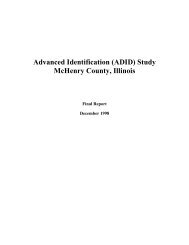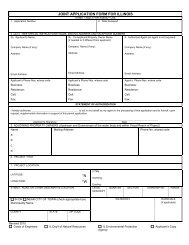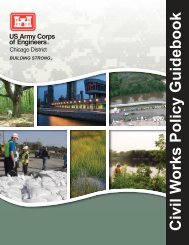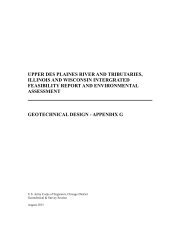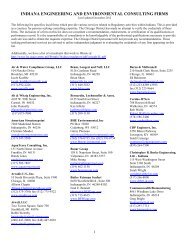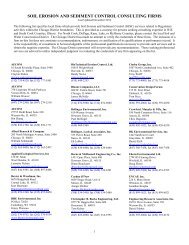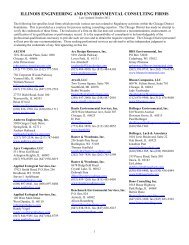Regional Permit Program - Chicago District - U.S. Army
Regional Permit Program - Chicago District - U.S. Army
Regional Permit Program - Chicago District - U.S. Army
You also want an ePaper? Increase the reach of your titles
YUMPU automatically turns print PDFs into web optimized ePapers that Google loves.
g. The project shall employ permanent Best Management Practices (BMPs) to protect water quality,preserve natural hydrology and minimize the overall impacts of development on aquatic resources.BMPs shall be considered at the earliest planning stages of the project.The applicant shall design the project to include the preservation of natural resource features such asfloodplains, streams, lakes, steep slopes, significant wildlife areas, wetlands, natural depressions anddrainageways, prairies, woodlands, sensitive aquifers and their recharge areas and native soils. Inaddition, the design elements utilized by the applicant shall include an appropriate combination of thoseprovided on the list below:1) Minimize mass grading and disturbance of soils.2) Lay out streets and lots to conform to the natural topography of the site.3) Minimize new impervious surfaces by clustering of facilities, minimizing street widths and parkinglots and reducing lot sizes and building setbacks.4) Preserve and create natural landscaping, buffers and filter strips.5) Utilize permeable areas to maximize infiltration of runoff into the ground through the use ofbiofilters, filter strips, bioswales, infiltration trenches, permeable pavement and native vegetatedopen spaces.6) Direct runoff to permeable areas and/or utilize stormwater for reuse by:a. Directing roof runoff towards permeable surfaces, drywells, French drains, vegetated swales, orother BMPs instead of driveways or other non-permeable surfaces.b. Grading impervious surfaces to direct runoff to permeable areas, utilizing level spreaders orother methods to distribute the runoff onto pervious surfaces.c. Using cisterns, retention structures or rooftops to store precipitation or runoff for reuse.d. Removing berms and designing pavement edges (e.g., curb cuts) in order to direct water topermeable landscaped areas.7) Improve water quality of stormwater leaving the site through the use of a naturalized detention basindesigned to maximize the removal and transformation of runoff pollutants. The design shouldinclude:a. Emergent vegetation in the bottoms of the wetland basins and along the periphery of wet bottombasins and side slopes vegetated in native prairie (traditional dry bottom basins are not approvedBMPs).b. Stilling basins at detention basin inlets and maximizing the distance between inlets and the basinoutlet.c. Installation of pre-settling systems such as forebays, mechanical stormwater treatment units, orsimilar structures, prior to discharge of stormwater into detention/retention facilities.d. Detention/retention facilities should be designed so that discharges from outlet structures aredirected to level spreaders prior to entering adjacent/downstream aquatic resources.A written narrative shall be included with the notification which describes how the BMP hierarchyabove was used in determining the water quality protection practices selected for the project site.19



